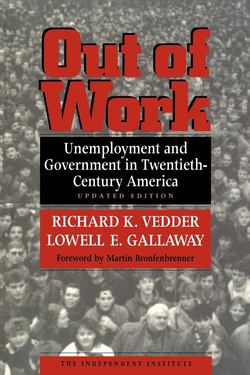Читать книгу Out of Work - Richard K Vedder - Страница 32
На сайте Литреса книга снята с продажи.
Criticisms of the Model
ОглавлениеThe model presented in (4) above is very unfashionable these days. To most contemporary mainstream economists, it is naively low tech, a simple single equation. Allegedly, far more complex models are capable of dealing with the material of the simple model while also offering more profound insight. The model here is appropriate for 1950 or possibly even 1970, but not 1990 or beyond, since econometric knowledge has expanded in the past generation. Also, it focuses directly on the labor market, whereas most economists of the mid- and late twentieth centuries have tended to explain unemployment indirectly by looking at other markets, in particular money markets. The model does not talk about consumption or investment or the stock of money or interest rates or any of the other things that economists usually bring up in discussing unemployment.
The approach here is even subject to criticism by the one group of economists that in general solidly agrees with the conclusions, the Austrian school. Austrian economics, which has had a healthy resurgence in recent years, tends to be highly skeptical of econometric and mathematical work.13 The Austrians tend to reject the modern scientific perspective that there is no a priori knowledge. Also, they question the aggregation used in constructing data series. For example, there are very serious conceptual problems in the construction of price indices, not to mention practical difficulties. Thus the approach used by us is criticized by one group of economists as being insufficiently empirical and by another group as being excessively empirical and quantitative.
Regarding the mainstream criticism, it is our goal to communicate our ideas to an audience of intelligent laypersons as well as to professional economists, and highly complex econometric models are beyond the understanding of much of our audience. Great economists from Smith to Keynes wrote books that the intelligent layperson could largely understand; current economic analysis is beyond the comprehension of that audience, and we view that as unfortunate. Later, we will deal with some of the specific objections to the model, but would note here that it seems to work well in describing the realities of twentieth-century unemployment variations. Moreover, the most straightforward way to look at unemployment is to look directly at labor markets, rather than indirectly at other markets that might have an impact on labor demand and supply.
As to the Austrian critique, we are increasingly sympathetic to some of the criticisms of the quantitative approach, a criticism that has spread to some of the leading econometricians themselves.14 Still, to convince the unconverted in modern times that one’s theory is valid, one must present some empirical evidence. To win consideration of one’s views, one has to use the appropriate rhetoric. The current “rhetoric of economics,” to borrow from Donald McCloskey, is econometrics.15 Hopefully, the empirical approach used here is quantitative enough to command attention of academic economists, but descriptive enough to command the attention of the public, even if the rhetorical approach is not perceived as ideal by either group.
Furthermore, the overwhelming majority of economists (including ourselves) reject the Hayekian view that the Austrian approach is inherently untestable. While quantitative economics is not infallible, we believe there is overwhelming solid evidence that the use of statistical method strengthens our knowledge of economic theory and our understanding of institutional arrangements. While economic propositions cannot be proven with absolute certainty, econometrics can strongly demonstrate their real-world insight in a convincing manner. Virtually every economist, for example, accepts empirically verified propositions that the quantity of almost any good demanded varies inversely with its price, or that increases in the quantity of money are associated with increases in prices. The validity of hypotheses about human economic behavior has been successfully demonstrated on countless occasions by the use of techniques similar to those used in this book.
